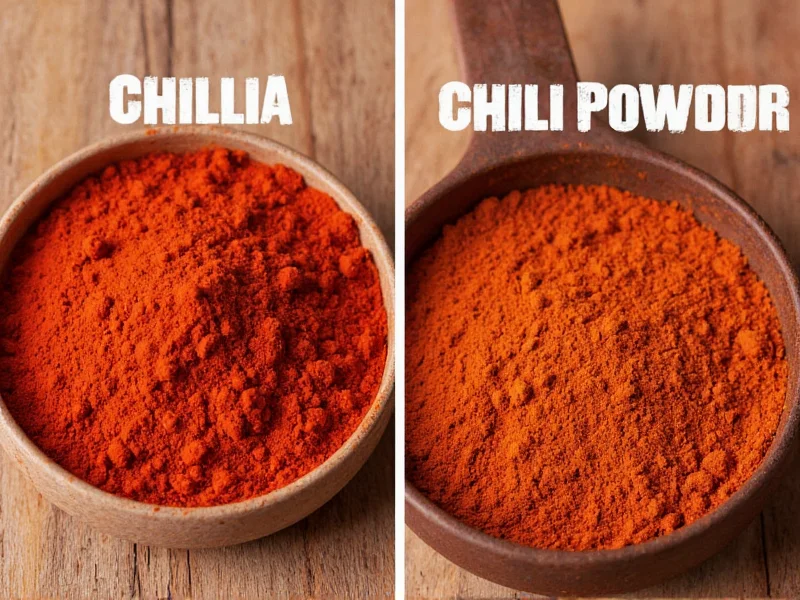Understanding the distinction between cayenne and chili powder is essential for precise cooking and recipe execution. Many home cooks mistakenly treat these spices as interchangeable, leading to disappointing results in their culinary creations. This comprehensive guide clarifies the fundamental differences to help you make informed choices in your kitchen.
What Exactly Is Cayenne Pepper?
Cayenne pepper refers specifically to a single-ingredient spice made from grinding dried cayenne peppers, a variety of Capsicum annuum that originated in French Guiana but now grows worldwide. These slender, pointed red peppers deliver significant heat without the complexity of additional seasonings.
True cayenne pepper contains only one ingredient: ground cayenne chilies. When properly processed, it maintains a consistent heat level between 30,000 and 50,000 Scoville Heat Units (SHU), placing it firmly in the medium-hot category of peppers. The flavor profile is straightforward—sharp, pungent heat with subtle fruity undertones and minimal complexity beyond the heat itself.
Understanding Chili Powder Composition
Chili powder is fundamentally different as it's a spice blend rather than a single-ingredient product. While formulations vary by brand and region, authentic chili powder typically contains:
- Ground dried chilies (often ancho, cayenne, or other varieties)
- Ground cumin
- Garlic powder
- Onion powder
- Oregano
- Salt (in some commercial blends)
The heat level of chili powder ranges dramatically from mild to medium, generally falling between 1,000 and 2,500 SHU. This variation occurs because chili powder's heat depends on which chilies were used in the blend and their proportions. The inclusion of other spices creates a more complex flavor profile with earthy, smoky, and aromatic notes beyond simple heat.
Key Differences Between Cayenne and Chili Powder
| Characteristic | Cayenne Pepper | Chili Powder |
|---|---|---|
| Composition | Single ingredient: ground cayenne peppers | Spice blend with multiple ingredients |
| Heat Level | 30,000-50,000 SHU (medium-hot) | 1,000-2,500 SHU (mild to medium) |
| Flavor Profile | Sharp, direct heat with subtle fruitiness | Complex blend of heat, earthiness, and smokiness |
| Primary Culinary Use | Adding pure heat to dishes | Creating foundational flavor in chili, tacos, and stews |
| Substitution Ratio | Use 1/4 tsp cayenne for 1 tbsp chili powder | Not recommended as direct substitute for cayenne |
When to Use Each Spice: Practical Applications
Understanding the appropriate context for each spice prevents recipe disasters. Cayenne pepper shines when you need pure, unadulterated heat without additional flavors interfering. It's ideal for:
- Adding heat to sauces without altering flavor profile
- Spicy Bloody Mary cocktails
- Cayenne-spiced chocolate or desserts where clean heat is desired
- Southern-style hot sauces
- Health tonics (cayenne is commonly used in wellness remedies)
Chili powder, by contrast, serves as a foundational seasoning in many dishes. It's essential for:
- Authentic Texas-style chili con carne
- Taco seasoning blends
- Enchilada sauces
- Southwestern-style rubs for meats
- Bean dishes requiring complex seasoning
Common Misconceptions Clarified
Several persistent myths confuse home cooks about these spices. First, cayenne is not just "hotter chili powder"—they're fundamentally different products. Second, "chili powder" doesn't necessarily mean "spicy powder"—many commercial blends are quite mild. Third, "cayenne pepper" and "red pepper flakes" are not the same—red pepper flakes contain seeds and membranes that create different heat characteristics.
Another critical distinction: in some regions (particularly the UK and Australia), "chili powder" refers to pure ground chilies rather than a blend. Always check ingredient labels to understand what you're purchasing, as regional naming conventions vary significantly.
Substitution Guidelines for Recipe Success
When substituting between these spices, proceed with caution. To replace chili powder with cayenne:
- Use only 1/4 to 1/2 teaspoon cayenne for every tablespoon of chili powder
- Add complementary spices: 1/2 tsp cumin, 1/4 tsp garlic powder, and 1/4 tsp oregano per tablespoon of chili powder replaced
- Always add gradually and taste as you go
Substituting chili powder for cayenne is more challenging but possible in some applications:
- Use 1.5 to 2 tablespoons chili powder for every 1/4 teaspoon cayenne
- Be aware this will introduce additional flavors beyond heat
- Best suited for dishes where the extra spices complement the recipe
Storage Recommendations for Maximum Freshness
Both spices lose potency over time but require similar storage conditions. Keep them in airtight containers away from light, heat, and moisture. Properly stored:
- Cayenne pepper maintains peak quality for 2-3 years
- Chili powder (as a blend) typically lasts 1-2 years before flavors degrade
- Freezer storage extends shelf life by 50% for both spices
Test potency by rubbing a small amount between your fingers and smelling—fresh spices should have vibrant aroma. If the scent is faint or musty, it's time to replace your supply.
Regional Variations and Labeling Confusion
The confusion between cayenne and chili powder is compounded by regional labeling differences. In the United States, "chili powder" almost always indicates a spice blend, while in the United Kingdom, "chili powder" typically means pure ground chilies (what Americans would call cayenne pepper).
When purchasing international recipes or shopping abroad, always check ingredient lists rather than relying on product names. Some specialty stores sell "pure chili powder" which is actually single-variety ground chilies, adding another layer to the confusion.











 浙公网安备
33010002000092号
浙公网安备
33010002000092号 浙B2-20120091-4
浙B2-20120091-4